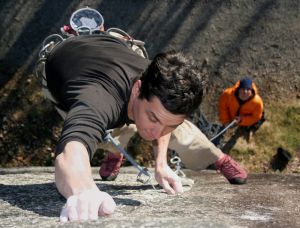
Common Rock Climbing Injuries by Jennifer Truong
April, 2013
Contrary to popular belief, rock climbing is a sport that involves more than just upper body strength. As any individual who has tried climbing knows, the sport also involves precise balance and flexibility, as well as considerable core and leg strength and endurance. Consequently, while most injuries resulting from rock climbing tend to be localized in the hands, arms, and shoulders, climbing is a full-body strengthening workout and can thus lead to injuries in all parts of the body. Inherent within the nature of the sport, climbers frequently subject their bodies to repetitive traumatic forces, whether from throwing to reach holds (dynoing and deadpointing) or falling from climbs (especially with bouldering), which results in either overuse injuries or acute injuries.
With the growing popularity of indoor rock climbing gyms and the expansion of these gyms in the Bay Area, it is important for climbers to be aware of possible injuries and practice preventative measures when possible.
What are common issues/areas of injury associated with rock climbing?
Upper extremity:
Shoulders – Most shoulder injuries in climbing can occur during traumatic force or events to the shoulders, for example with catching a dyno or deadpoint. Rotator cuff muscles strains or tears are characterized by acute pain and inability to lift the arm(s) above shoulder height. If not allowed to heal properly, these strains/tears can lead to shoulder impingement. Rotator cuff tendonitis (RTC) is distinguished by more dull pain and stiffness that may fluctuate during the day and throughout your climbing workout. Biceps tendonitis is also similar to RTC, which can be differentiated from rotator cuff issues by a doctor or physical therapist. While muscle tears may need to be treated by a doctor/surgery, many other shoulder impairments can be resolved with physical therapy.
Labrum tears (aka SLAP lesions) can also be caused due to traumatic or repeated force to the shoulder (i.e. from dynamic climbing or gaston-type moves) and are characterized by dull pain, shoulder instability, and a “catching” sensation within the joint. With a torn labrum, the shoulder may dislocate more frequently, further aggravating the injury, so it is important to seek early treatment. Depending on the extent of the injury, some treatment may not require surgery and can be treated with physical therapy alone. More serious labrum injuries are treated with surgery, followed by extensive physical therapy, https://nygoodhealth.com.
Elbows – Elbow injuries occur in the tendons connecting to the elbow, resulting in pain and stiffness during activity1. Medial/Lateral epicondylitis can occur in either side of the elbow and is more commonly known as either golfer’s elbow (medial side, and is also known as climber’s elbow) or tennis elbow (lateral side). Golfer’s elbow is more common in climbers since it involves the tendon that connects to the finger flexing muscles, or the muscles involved in gripping.
Tendonitis of the triceps or brachialis may also occur during climbing. Repetitive motions, especially with locked-off bent-arm positions, dead-hangs, or mantling (straightening the arm below one’s body to bear weight) movements during climbing can cause damage to these muscles and their tendons, leading to pain and weakness around and inside of the elbow joint. Unfortunately, with elbow tendon injuries, recovery may be slow. Patients need to follow strict regimen of exercises for recovery, otherwise there may be chronic pain.
Wrists/Hands – Wrist and hand injuries are the most frequent injuries in climbing2. Disc injuries (Triangular Fibrocartilage Complex – TFCC) are overuse injuries affecting cartilaginous tissues in the wrist. These discs can be torn or compressed from climbing on sloper holds because of the open-handed position. TFCC injuries are characterized by a “persistent dull ache” or sharper pain, especially on pinky side of wrist. Aside from cartilaginous injuries, the open handed position can also cause torque or shearing forces, leading to dislocation/subluxation of the carpal bones in the wrist. These dislocation issues often do not require any invasive techniques and may be corrected by a physical therapist.
Ligament sprains and strains or tears/ruptures of the annular pulleys (sheaths of connective tissue holding your finger tendons) are some of the most common overuse injuries in climbers, especially due to closed-hand crimping. When such an injury occurs, often a popping or snapping sound occurs. Pulley injuries are marked by pain/tenderness upon manipulation, swelling, and possibly visible bowstringing of the tendon away from the finger bones if the sheath is completely ruptured; diagnosis can be done quickly with dynamic ultrasonography3. Tendinitis and tenosynovitis may also occur as inflammation of the tendon sheaths or joints and are characterized by pain, swelling, reduced function, and stiffness. Avoiding constant closed-hand crimping is essential for healing, in conjunction with rest, inflammation management, massage/manual therapy, and stretching. In addition, stress fractures are a less common concern during climbing, but are still possible with the forces exerted on the fingers during crimping. Working with a PT will enable a patient to recover from these inhibitive injuries without having to completely sacrifice climbing.
Lower Extremity:
Knees – Less intuitively, knees are also a common area of injury for climbers. The repetitive stress from falling during bouldering sessions can easily lead to damage of the meniscus, or any of the tendons or ligaments within the joint. These same connective tissues are also strained during regular climbing positions if climbers do not have enough hip flexibility. Toeing down or edging on small holds with the hips open and heels raised can lead to abnormal forces exerted on the knees. Drop knees (inward rotation of the hip while maintaining leg tension) can also cause large amounts of stress on the knee, leading to injuries as minor as bursitis (inflammation of a bursa) or as major as a dislocated patella.
Ankles – Due to the repetitive falling inherent with rock climbing (whether during bouldering or roped climbing), ankles are often at risk for sprains and fractures, especially with the soft and flexible shoes used for climbing. Learning proper falling and landing technique is crucial for prevention, as well as careful spotting and belaying of others.
How PT can help
Many climbers are impatient to return to their sport and refuse to rest, which can be inhibitive to proper healing. Physical therapy can offer a viable recovery and treatment option that does not necessarily require a hiatus from climbing. A physical therapist can guide you through the healing of your injury to help stretch, strengthen and support the area. While providing specific care for your issue, your therapist can also teach ways that allow for smarter climbing to prevent the occurrence of future injuries.
About the author:
Jennifer Truong graduated from UCLA with a B.S. in Physiological Science and is a member of the aide team at Breakthrough Physical Therapy. She will be starting at the UCSF/SFSU Doctor of Physical Therapy program in 2013. She has been an avid climber for 6 years and has climbed in many outdoor locales throughout California, from Joshua Tree and Black Mountain to Lake Tahoe, Yosemite, and Bishop.
References:
1 http://orthoinfo.aaos.org/topic.cfm?topic=a00068
2 http://bjsm.bmj.com/content/38/5/545.full.pdf
3 http://orthoinfo.aaos.org/topic.cfm?topic=a00068
ALSO SEE : Does long distance running cause osteoarthritis of the knee?



